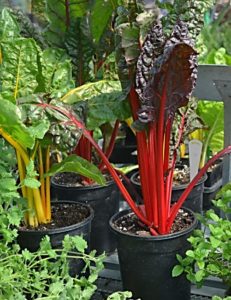Container Gardening
February 24, 2021
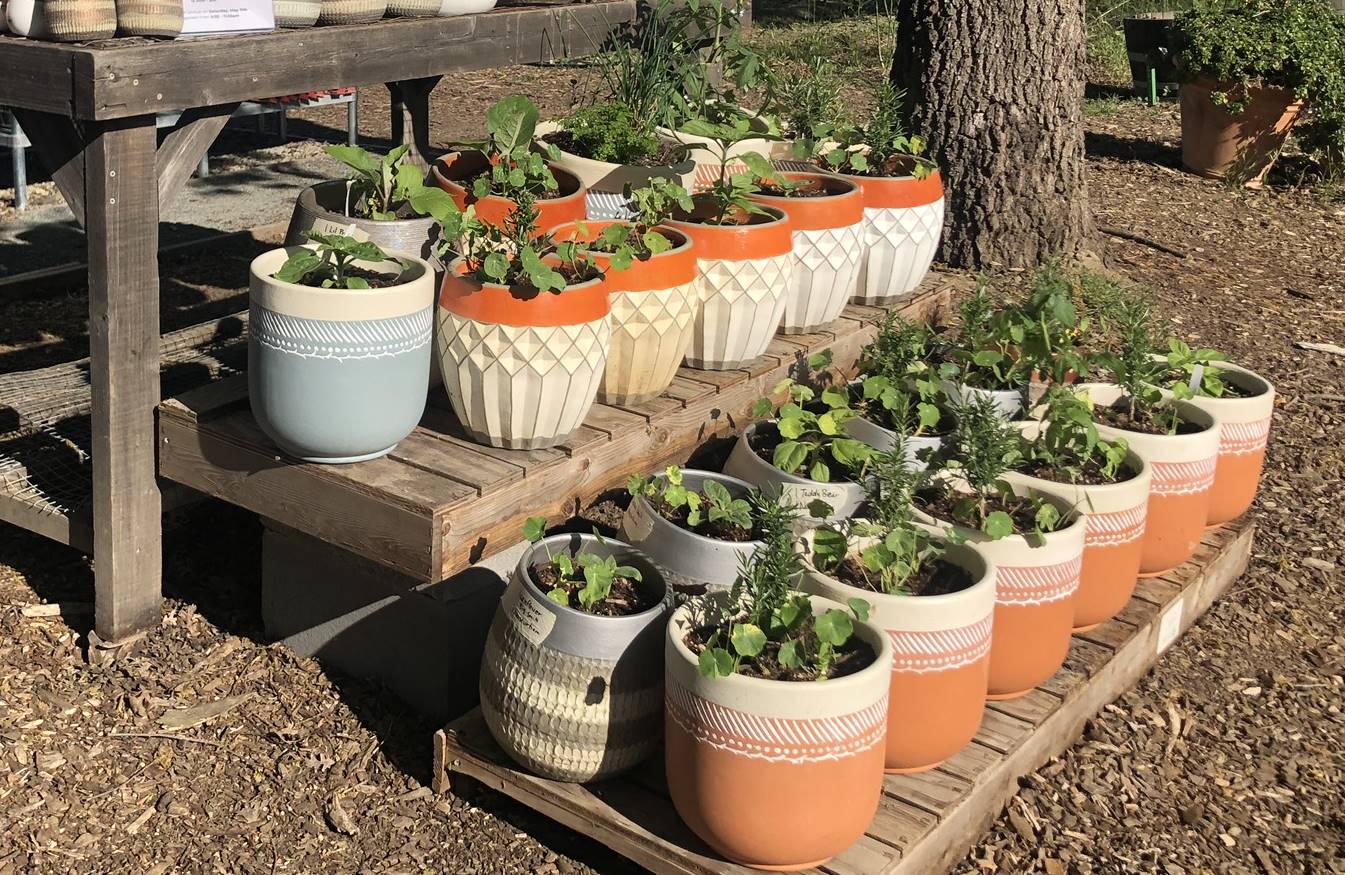
The last few days have felt like spring here in the Bay Area, with warm, sunny days, cool breezes, and chilly nights. Springtime always gets me thinking about planting! As the Garden Coordinator for the Sunflower Hill Garden, I’m honored to be able to plant and care for a LOT of different varieties of fruits, vegetables, herbs, and flowers. But not everyone has access to a large plot of land to grow food and beautiful flowers. That’s why I love container gardening. Whether you’re short on space or wanting to start out simple, container gardening is an easy, cost-effective, and accessible way to get started growing your own food!
Container Gardening
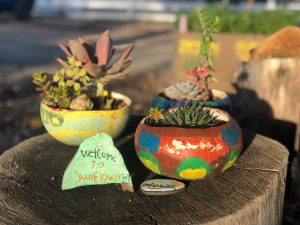 Container Gardening refers to using containers for plants instead of putting them directly into the ground. Gardening in containers is a great option for when you only have a small space to garden. It’s also a wonderful adaptive option for those who want to garden, but find aspects of traditional gardening in the ground challenging.
Container Gardening refers to using containers for plants instead of putting them directly into the ground. Gardening in containers is a great option for when you only have a small space to garden. It’s also a wonderful adaptive option for those who want to garden, but find aspects of traditional gardening in the ground challenging.
Container gardening allows you to:
- Make your garden mobile: easily move your small garden containers from the ground, to a table, bench, or some other easily accessible area.
- Limit the labor-intensiveness of in-ground growing.
- Grow anywhere: porch, deck, balcony, or sunny window sill.
- Limit your harvest loss to produce-eating gophers.
- Experiment with different plants with minimal investment.
- Grow gifts to share with others!
Why Container Garden?
Container gardening is an easy way to grow fresh food – vegetables, fruits, and herbs as well as beautiful flowers to brighten your day. In addition to the health benefits of growing and eating your own produce, container gardening has several additional benefits and uses:
- Increase your steps – planting, watering, and caring for your container garden will get you moving more throughout the day!
- Increase the variety of foods you eat. You’re more likely to try (and like!) food you’ve grown yourself!
- Unique gift ideas – grow sweet smelling herbs and make herb gift bundles to promote relaxation and sleep; or fresh flowers to mix and match in a bouquet. Succulents are also an easy-care plant to share with others!
- Entertain a cat – whether it’s your cat or a friend’s cat, growing catnip herb for your favorite feline is sure to provide some funny moments!
Planning Your Container Garden
Before choosing a container and plants, consider the location where you want your container plants to reside. It should meet your accessibility needs and get several hours or more of direct sunlight. Also consider how mobile you’ll need your container garden to be. Will you need to move the container for easier interaction like watering and harvesting? The bigger the container, the heavier it will be after you add the soil and plant. Smaller containers will be easier to move, while larger containers will need to remain in place once you add the soil and plant.
Types of Containers
There are many different types of containers, from homemade varieties to pre-made options that you can purchase online or in garden stores like your local plant nursery, Lowe’s, or Home Depot. Below are a few pre-made suggestions. One thing to note: try not to use terra cotta pots as they are very absorbent and might rob your plants of valuable water. See below for several different container options I recommend:
Small Containers: These small containers are great for getting started with your own garden. They’re super lightweight, have good drainage, and can be moved around easily both indoors and outside. Or, for a truly economical planter, try an old yogurt container to plant your favorite herbs.
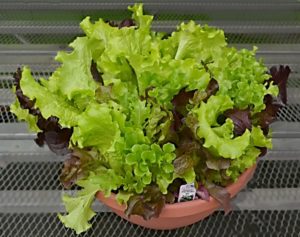 Medium Containers: I love this easy-to-move lettuce bowl. This is a shallow but wide plastic planter, and perfect for lettuce which has shallow roots. You can place this on a windowsill or on a kitchen table with some direct sun. Another option are these small to medium-sized fabric containers, which are economical and provide excellent drainage.
Medium Containers: I love this easy-to-move lettuce bowl. This is a shallow but wide plastic planter, and perfect for lettuce which has shallow roots. You can place this on a windowsill or on a kitchen table with some direct sun. Another option are these small to medium-sized fabric containers, which are economical and provide excellent drainage.
Large Containers: For a larger planter, these 15-gallon, plastic garden containers are economical and are still relatively easy to move once you add soil and plant.
Regardless of what type of container you choose, make sure that it meets your accessibility needs.
Types of Plants
With an idea of what type of container you want to use for your container garden, your next step is to choose some veggies, fruits, herbs, or flowers to plant. What can you grow in a container? Here are just a few suggestions:
- Edible plants (vegetables, fruits, herbs): thyme, oregano, cilantro, basil, lettuce, mixed greens, chard, kale, rosemary, chamomile, and catnip.
- Non-edible plants: bulb flowers like daffodil, tulip, hyacinth, or paper whites, succulents, and daisies.
Medium-to-Large containers
- Edible plants (vegetables, fruits, herbs): rosemary, tomato, eggplant, lemon, kumquat, potato, peppers, cucumber, pole beans, melons.
- Non-edible plants: zinnias, strawflower, bachelor buttons, calendula, and more. Avoid sunflowers and dhalias as they have deep roots.
Don’t be afraid to try new veggies, fruits or herbs! It can be fun to experiment. Need more ideas on what to grow in containers? Talk with your local plant nursery. They’ll be able to give you many more suggestions.
Get Planting
Once you’ve selected your ideal container(s) and a few different plant varieties, it’s time to get planting!
Start with your soil. You can find potting soil at any garden store (like a local plant nursery, Lowes, Home Depot, etc.) They’ll often have potting soil that is specific to vegetable, citrus or fruiting vines, but the general potting soil works too. You’ll want to buy enough potting soil to fill all of your containers.
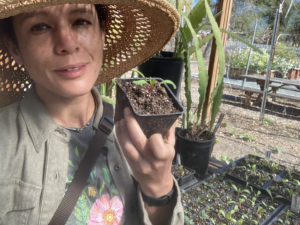 You have two options when it comes to plants: plant ‘starts’ and seeds. A plant start is a plant that has been started from seed or a cutting, typically indoors or in a protected area. It’s been grown for several weeks and is now old enough to be planted outdoors or transplanted into a container. I recommend buying plant starts when possible. Using a plant start (instead of seed) is a great way to jump-start your garden.
You have two options when it comes to plants: plant ‘starts’ and seeds. A plant start is a plant that has been started from seed or a cutting, typically indoors or in a protected area. It’s been grown for several weeks and is now old enough to be planted outdoors or transplanted into a container. I recommend buying plant starts when possible. Using a plant start (instead of seed) is a great way to jump-start your garden.
However, some plants do better from seed. Typically, these are root plants that don’t like to be transplanted once they get started. Some of these plants include carrots, lettuce, turnips, beets, snap peas, green beans, and melon to name a few. If you plan to try any of these plant varieties, use seeds and follow the care and maintenance instructions on the seed packet.
Whether you choose to use plant starts or seeds, follow the planting and care instructions that are provided with each plant to get your container garden growing!
Delicious Experiments
With spring just around the corner, now is a great time to plan and start your container garden. Choose a container (or two) and your favorite fruit, vegetable, or herb and enjoy experimenting with delicious results! Happy Growing!
More Resources on Container Gardening
Here are a few of my favorite resources for all things related to container gardening!
- The Vegetable Gardener’s Container Bible: How to Grow a Bounty of Food in Pots, Tubs, and Other Containers
- Grow Food For Free: The Sustainable, Zero-cost, Low-effort Way to a Bountiful Harvest
- Container Gardens: Over 200 Fresh Ideas for Indoor and Outdoor Inspired Plantings
Story by: Andrea del Rio, Garden Coordinator
Contributing Writer: Rachel Clark, Communications Manager
